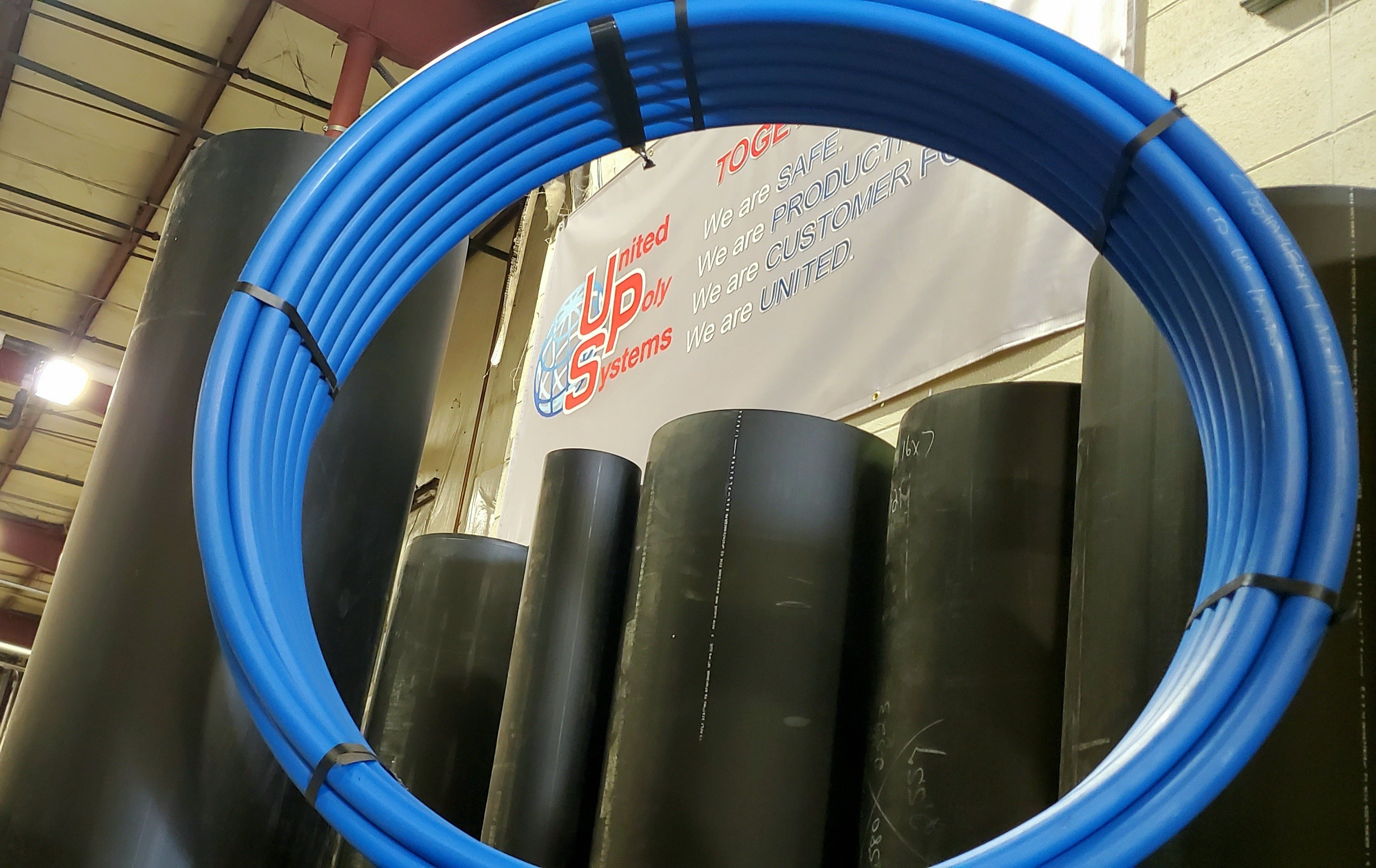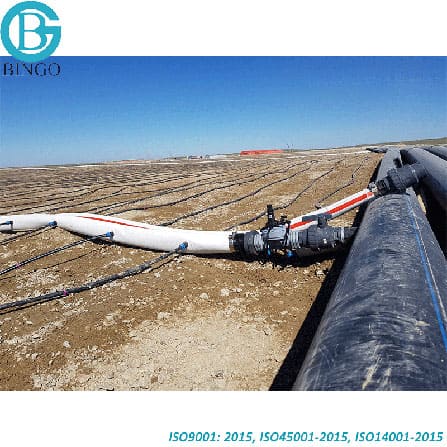Why Pipe Supplier American Plastics Midland Is the Trusted Partner for Contractors
Discover the Manufacturing Refine Behind High-Quality HDPE Pipe and Its Applications
The manufacturing procedure of high-grade HDPE pipelines is detailed and systematic. It begins with the selection of basic materials that boost performance. Following this, ethylene undergoes polymerization to create material, which is then shaped through extrusion. Quality assurance is critical, making certain that the end product fulfills rigid requirements. The journey of HDPE pipelines doesn't end with manufacturing. Their applications throughout different markets expose a more comprehensive importance worth examining.
Recognizing HDPE: Residences and Advantages

High-density polyethylene (HDPE) is a flexible thermoplastic understood for its toughness and resistance to various environmental variables. This product displays superb tensile strength, making it appropriate for requiring applications. Its low-density structure adds to a lightweight product, facilitating simplicity of taking care of and installation. HDPE likewise showcases amazing resistance to chemicals, which decreases deterioration when exposed to severe compounds.
The material's reduced moisture absorption even more boosts its longevity, making it ideal for use in pipelines and storage tanks. In addition, HDPE is resistant to ultraviolet (UV) radiation, making sure that items keep their stability also when exposed to sunshine. Its versatility permits for the production of intricate shapes without jeopardizing strength. The green nature of HDPE, usually stemmed from recycled products, includes in its appeal, promoting sustainable techniques in manufacturing. Overall, these properties and benefits make HDPE a preferred option for various industrial and consumer applications.
Raw Material Choice for HDPE Manufacturing
The option of resources for HDPE manufacturing is vital to confirm the end product fulfills the wanted specifications and quality criteria. High-density polyethylene (HDPE) is primarily generated from polymerized ethylene, obtained from nonrenewable fuel sources such as natural gas or unrefined oil. The quality of these feedstocks significantly influences the mechanical and thermal residential properties of the final HDPE.
Additives also play a substantial duty in improving HDPE's performance, consisting of anti-oxidants, UV stabilizers, and colorants, which improve durability and resistance to environmental variables. The choice procedure should think about not only the chemical composition of the raw products however also their handling qualities to assure effective production.
The sourcing of raw products ought to prioritize sustainability and compliance with environmental guidelines, as liable techniques are imperative in today's market. Inevitably, cautious resources option lays the foundation for producing top quality HDPE pipelines suitable for varied applications.
The Extrusion Process: Shaping HDPE Pipe
The extrusion procedure plays an essential function in forming HDPE pipes, starting with thorough material preparation strategies that guarantee suitable circulation and consistency. Similarly vital is the design of the die, which straight influences the last measurements and surface top quality of the pipe. With each other, these elements add greatly to the efficiency and quality of HDPE pipe production.
Material Prep Work Strategies
Reliable manufacturing of HDPE pipelines starts with meticulous material preparation methods, specifically the extrusion process. Throughout this phase, high-density polyethylene resin is very first dried to remove dampness, guaranteeing excellent circulation features. The material is after that fed right into the extruder, where it undergoes heating and melting, changing into a viscous state. This heating process is thoroughly managed to preserve the material's integrity and efficiency. The liquified HDPE is required with a die, shaping it into a continual pipeline kind. Appropriate temperature level monitoring throughout extrusion is essential, as it directly impacts the product's homes and the end product top quality. When formed, the HDPE pipe is cooled down and cut to defined lengths, all set for subsequent processing and applications.
Die Layout Significance
Accuracy in die style plays an essential role in the extrusion procedure of HDPE pipelines. The die serves as the last shaping tool, directly affecting the pipe's measurements, wall density, and surface finish. A properly designed die guarantees consistent product flow, lowering flaws such as irregularities and weak points. The geometry of the die need to be optimized to suit the certain buildings of HDPE, including its viscosity and thermal behavior throughout extrusion. Additionally, the cooling price of the material as it passes via the die can considerably influence the pipeline's architectural integrity. Consequently, spending in sophisticated die modern technology is crucial for manufacturers intending to generate top notch HDPE pipes that satisfy industry requirements and consumer expectations.
Quality Assurance Measures in HDPE Manufacturing
Although various variables affect the quality of HDPE pipeline production, effective high quality control actions are crucial to ensure uniformity and reliability in the final item. Secret quality assurance methods include read more extensive product inspection, verifying that the raw polyethylene satisfies well established criteria for pureness and density. During the extrusion procedure, criteria such as temperature level, pressure, and cooling time are carefully checked to preserve dimensional precision and structural integrity
Furthermore, post-production testing is crucial; makers typically carry out hydrostatic tests to examine the pipe's stamina and resistance to stress. Aesthetic assessments for surface defects better boost high quality assurance. Certification from relevant criteria organizations, like ASTM or ISO, provides an added layer of reputation. By carrying out these thorough quality assurance procedures, producers can minimize issues, enhance efficiency, and make sure that the HDPE pipes fulfill the particular requirements of different applications, ultimately bring about client satisfaction and trust fund in the product.
Applications of HDPE Pipeline Across Industries
HDPE pipes are used across numerous markets because of their sturdiness and versatility. In water circulation systems, they assure reliable distribution, while in wastewater administration, they provide reliable solutions for waste transportation. Furthermore, farming watering networks gain from HDPE's resistance to rust and adaptability, making it a suitable option for modern-day farming methods.

Water Circulation Equipments
A considerable number of industries count on high-density polyethylene (HDPE) pipelines for effective water distribution systems. Recognized for their toughness and resistance to rust, HDPE pipes are extensively used in local supply of water networks, agricultural watering, and commercial applications. Their lightweight nature assists in very easy handling and installation, minimizing labor costs and time. Additionally, HDPE pipelines can fit various stress levels, making them ideal for both low and high-pressure systems. American Plastics HDPE Pipe for Oilfield. The versatility of the product permits smooth combination right into existing facilities, reducing the demand for substantial excavation. Moreover, HDPE's resistance to chemical seeping warranties that the water supplied stays safe and tidy, making it a perfect choice for maintaining the quality of safe and clean water across numerous markets
Wastewater Administration Solutions
Effective water distribution systems likewise lead the way for cutting-edge wastewater management services, where high-density polyethylene (HDPE) pipelines play a significant function. Renowned for their sturdiness and resistance to corrosion, HDPE pipes are perfect for carrying wastewater in various setups. Their adaptability enables very easy installation in intricate environments, reducing the need for considerable excavation. In addition, HDPE's smooth interior surface lowers rubbing, enhancing circulation prices and effectiveness. These pipelines are likewise immune to chemical leaching, making sure that pollutants do not endanger the surrounding setting. Industries, districts, and therapy facilities significantly depend on HDPE pipelines for their reliability and durability, making them a recommended selection for modern wastewater administration systems. This adaptability emphasizes the important significance of HDPE pipelines across countless applications.
Agricultural Irrigation Networks
Agricultural watering networks benefit substantially from the use of high-density polyethylene (HDPE) pipelines, which provide reliable and dependable water distribution to crops. HDPE pipelines are light-weight, making them simple to move and set up, while their adaptability enables for numerous configurations in diverse surfaces. These pipes demonstrate excellent resistance to rust, chemicals, and UV radiation, making certain toughness in severe farming atmospheres. Additionally, their smooth indoor surface minimizes rubbing loss, optimizing water circulation and decreasing power expenses related to pumping. The durability of HDPE pipes, usually surpassing half a century, adds to lower upkeep and substitute costs. Subsequently, farmers progressively count on HDPE pipes to improve irrigation effectiveness and advertise sustainable agricultural techniques, ultimately bring about enhanced crop yields and resource preservation.
Future Fads in HDPE Pipe Innovation
As the need for sustainable and reliable infrastructure grows, innovations in HDPE pipe innovation are positioned to transform different industries. Emerging fads consist of the combination of smart modern technologies, such as sensors and IoT capacities, which help with real-time surveillance of pipe problems, lowering maintenance expenses and protecting against leaks. In addition, the development of sophisticated manufacturing methods, such as 3D printing, is enabling the manufacturing of complex, tailored pipe designs that deal with details project needs.
Moreover, the concentrate on recycling and circular economic situation methods is driving the development of HDPE pipes made from recycled products, boosting sustainability. Boosted jointing methods, such as electro-fusion and mechanical fittings, are likewise improving installment efficiency and dependability. Ultimately, the growing focus on environmental guidelines is pressing manufacturers to adopt greener manufacturing procedures, guaranteeing that HDPE pipes not just satisfy sector criteria but also promote a more lasting future for facilities advancement.
Often Asked Questions
How Does HDPE Contrast to Various Other Plastic Materials?
HDPE outshines lots of other plastic materials regarding longevity, chemical resistance, and adaptability. Its reduced density and high tensile strength make it excellent for numerous applications, frequently exceeding options in both performance and longevity.
What Are the Ecological Influences of HDPE Production?
The ecological influences of HDPE manufacturing include greenhouse gas emissions, energy consumption, and prospective contamination from producing processes. In addition, inappropriate disposal can lead to soil and water contamination, increasing issues regarding lasting ecological impacts.
Can HDPE Pipeline Be Recycled?
Yes, HDPE pipelines can be reused. Lots of facilities accept made use of HDPE for handling, changing it right into brand-new items. This reusing adds to sustainability efforts, decreasing plastic waste while preserving resources and power in the production cycle.
What Is the Life Expectancy of HDPE Pipes?

How Do Temperature Level Variations Affect HDPE Pipeline Performance?
Temperature level variations greatly influence HDPE pipe efficiency, impacting flexibility and toughness. Heats can result in softening, while low temperature levels might trigger brittleness, ultimately influencing the pipeline's toughness and suitability for numerous applications in diverse atmospheres.